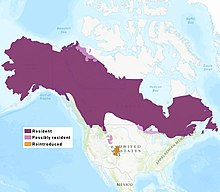| Canada lynx | |
|---|---|

| |
| Scientific classification | |
| Domain: | Eukaryota |
| Kingdom: | Animalia |
| Phylum: | Chordata |
| Class: | Mammalia |
| Order: | Carnivora |
| Suborder: | Feliformia |
| Family: | Felidae |
| Subfamily: | Felinae |
| Genus: | Lynx |
| Species: | L. canadensis
|
| Binomial name | |
| Lynx canadensis Kerr, 1792
| |
| Subspecies | |
|
See text | |

| |
| Distribution of the Canada lynx (2016)[1] | |
| Synonyms[2] | |
|
List
| |
The Canada lynx (Lynx canadensis) or Canadian lynx is one of the four living species in the genus Lynx. It is a medium-sized wild cat characterized by long, dense fur, triangular ears with black tufts at the tips, and broad, snowshoe-like paws. Its hindlimbs are longer than the forelimbs, so its back slopes downward to the front. The Canada lynx stands 48–56 cm (19–22 in) tall at the shoulder and weighs between 5 and 17 kg (11 and 37 lb). It is a good swimmer and an agile climber.
The Canada lynx was first described by Robert Kerr in 1792. Three subspecies have been proposed, but their validity is doubted; it is mostly considered a monotypic species. It ranges across Alaska, Canada and northern areas of the contiguous United States, where it predominantly inhabits dense boreal forests. It is a specialist predator and depends heavily on the snowshoe hare (Lepus americanus) for food. This leads to a prey-predator cycle, as the Canada lynx population responds to the cyclic rises and falls in snowshoe hare populations over the years in Alaska and central Canada. The Canada lynx population increases with an increasing hare population; if the hare population decreases in a given area, it moves to areas with more hares and has fewer offspring. The Canada lynx hunts mainly around twilight, or at night, when the snowshoe hare tends to be active. The Canada lynx waits for the hare on specific trails or in "ambush beds", then pounces on it and kills it by a bite on its head, throat or the nape of its neck. Individuals, particularly of the same sex, tend to avoid each other, forming "intrasexual" territories. The mating season is roughly a month long from March to early April. After a gestation of two to three months, females give birth to a litter of one to eight kittens, which are weaned at the age of 12 weeks.
Given its abundance throughout the range and lack of severe threats, the Canada lynx has been listed as Least Concern on the IUCN Red List. It is regularly trapped for the international fur trade in most of Alaska and Canada but is protected in the southern half of its range due to threats such as habitat loss.
- ^ a b c Vashon, J. (2016). "Lynx canadensis". IUCN Red List of Threatened Species. 2016: e.T12518A101138963. doi:10.2305/IUCN.UK.2016-2.RLTS.T12518A101138963.en. Retrieved January 24, 2022.
- ^ Cite error: The named reference
Tumlisonwas invoked but never defined (see the help page).
